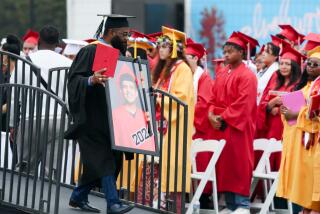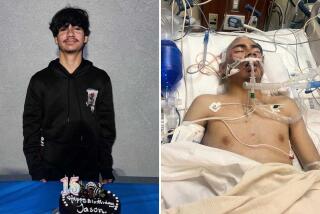‘Always Wear a Helmet’ : Hospital Sees Rising Number of Kids With Head Injuries
- Share via
MISSION VIEJO — Since June 11, life has been a blur for David Santos and his family.
On that day, his 16-year-old son, Brett, had a skateboarding accident and was placed on life support at Children’s Hospital at Mission with major head injuries.
“It’s a nightmare,” the Mission Viejo resident said of the accident that left his son in a coma for two weeks.
“My wife and I feel very hopeful. We trust he’ll have a 100% recovery.”
This past June, 11 children were admitted into Children’s Hospital at Mission with serious head injuries, an unusually high number for one month, officials said.
The hospital’s yearly average is 40.
“So many are avoidable,” neurological surgeon Dr. Sylvain Palmer said of the accidents.
According to statistics from the Brain Injury Assn. of Connecticut, traumatic brain injury is the leading killer and cause of disability in children and young adults.
Nationwide, 1 million children sustain head injuries each year. About 165,000 of those children will be hospitalized.
One in 10 will suffer moderate to severe impairments.
In Brett’s case, he fell off a skateboard while being towed behind a friend’s golf cart in Coto de Caza.
When his head hit the ground, the impact fractured his skull in two places. He was not wearing a helmet.
“It was an accident, but preventable,” David Santos said.
“I think the message is to always wear a helmet. . . . Understand that and take every precaution.”
California law, since January 1994, requires that all children under the age of 18 wear an approved helmet while riding a bike.
When worn correctly, tightly fit on top of the head one inch above the eyebrow, helmets have also been proven to prevent serious head trauma when skateboarding, in-line skating, mountain biking or riding a motorized scooter, said Mary Marlin, community education manager at Children’s Hospital at Mission and at Children’s Hospital of Orange County in Orange.
“We do know if a child puts a helmet on their head, we have an 85% chance of reducing head injury,” Marlin said.
“I wish families understood what happens when a child’s brain is injured. Damage to the brain is damage we live with. . . . It’s a lifelong change.”
For Brett, improvement comes with each new day. After being in an induced coma for two weeks, he was recently moved from the pediatric intensive care unit to an in-patient acute care rehabilitation facility at the hospital.
He is also talking to family and friends, who have flooded the hospital with cards, flowers and well wishes since the accident.
“He’s come a long way,” best friend Chris Roselli, 16, said. “It’s good to see him without tubes and stuff.”
David Santos said he hopes to someday see his son competing for his high school’s water polo and swim teams again.
Although Brett is improving, his doctors said it could be several years before they know the long-term impact, if any, the accident will have on his brain.
Sitting in the hospital’s waiting room, David Santos said parents need to educate their children to always take preventive safety measures so an innocent activity like biking or skating does not turn deadly.
“It can happen in a blink of an eye, and it changes your life,” Santos said. “It’s real hard.”
More to Read
Sign up for Essential California
The most important California stories and recommendations in your inbox every morning.
You may occasionally receive promotional content from the Los Angeles Times.













